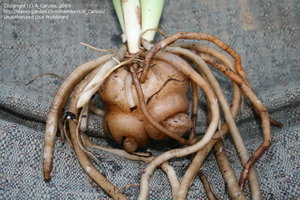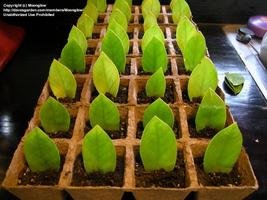





The ZZ plant (Zamioculcas zamiifolia) has only recently become a popular houseplant. It was not until 1999 the Florida growers started production of this unusual plant. It caught on quickly, though, and in 2002 was named the indoor foliage plant of the year by the Florida Nurserymen's and Growers' Association. Needless to say, it caught on quickly.
Reasons for its popularity are not hard to discern. The ZZ plant tolerates and even thrives on neglect, so even those who set their newly acquired plants in the corner and forget to water them for weeks on end can experience success. In fact, the plant seems to thrive on neglect. It does not require frequent waterings or feedings, and it does well in a poorly lit room. High resistance to insects and diseases further increase its desirability as a houseplant. In addition, the ZZ plant is capable of "cleaning" the indoor air and making it healthier for humans to breathe.
It is easy to understand the ZZ plant's common names; "ZZ plant" because of the scientific name, "fat boy plant" because of the fat tuber-like rhizomes that form at the base of each stem, "aroid palm" and "arum fern" because it is an aroid or arum that resembles certain palms and ferns, and "eternity plant" because it seems to live forever.
The genus name, "Zamioculcas" suggests its resemblance to the cardboard palm (Zamia furfuracea), which also seems confusing because the cardboard palm is not a palm. It, along with the sago palm (Cycas revoluta), are members of the Cycadaceae (cycad) family.
The ZZ plant is native to the dry grasslands and shady areas of lowland forests in eastern Africa. Glossy, almost oval shaped leaflets that are a bit broader toward the sharp-pointed tip line up in opposite formation along each stem. Oddly enough, the spacing of the leaves is far apart at the bottom, while at the top the leaves almost grow opposite each other. The flower, which is not showy, is characteristic of the aroid family and consists of an inflorescence called a spadix that is subtended by a spathe.
Culture and Propagation of ZZ Plant
ZZ plant appreciates a place in fairly bright light, even though it is even more tolerant of low-light conditions than most other low-light plants. Soil should be well-drained, and a dilute solution of liquid fertilizer can be applied four or five times a year while the plant is in active growth.
Propagation of the ZZ plant is easy, if slow. Each part of the plant is capable of regenerating itself. Of course, large plants are easily divided, and this is the fastest way to get another plant. However, cuttings root in water, or individual leaves can be stuck in well-drained potting mix where they can be expected to grow rhizomes and roots within a year. It takes a great deal of patience to get a new plant from cuttings, which explains why the plants are a bit pricey at the nursery.
The Aroid (Araceae) Family
The ZZ plant is a member of the Araceae (arum or aroid) family. According to GRIN Taxonomy, there are 106 genera in this family. Some of the genera have many species, from Philodendron with 66 species to Zamioculcas with only one species. Altogether there are about 3700 species of Araceae. All are monocots that have flowers borne in a type of inflorescence called a spadix that is sometimes partially enclosed in a spathe or leaf-like (bract) hood, which is sometimes colorful. Araceae are often rhizomatous or tuberous, although corms or stolons are sometimes present. Some arums contain calcium oxalate crystals and clear or milky sap, and can be toxic when ingested. All arums should be considered toxic and handled with care.
Family members include plants native to the United States, such as the skunk cabbages (Lysichiton spp. and Symplocarpus) and Jack-in-the-pulpits (Arisaema spp.), as well as a few invasive plants like the infamous water lettuce (Pistia stratiotes) and wild taro (Colocasia esculenta) that have infested waterways in several southern states. One arum, Amorphophallus titanum (titan arum) has largest unbranched inflorescence in existence. Some plants, including the aforementioned wild taro and some Xanthosoma have edible parts. Most, however, are simply beautiful, so the group makes up one of the most important segments of the indoor foliage plant industry.
Popular aroids include species of Aglaonema (Chinese-evergreen), Caladium, Epipremnum (pothos), Spathiphyllum (peace lily), Syngonium (arrowhead vine), Zantedeschia (calla-lily), and others. The largest collection of aroids is at Missouri Botanical Gardens.
Quirky Characteristics
Certain members of the aroid family have other characteristics worth noting. After observing the almost ethereal beauty of plants like Arum, Monstera, Philodendron, and Zantedeschia, it is hard for some people to realize that some are very obnoxious when they bloom. Obnoxious is perhaps a mild word to describe the vile, vomitous stench given off by the likes of our native skunk cabbages and the amazing titan arum. In addition, some are thermogenic (heat producing), which helps them to attract pollinators and prevents tissue damage in cold regions.
All-in-all, the arums make up an interesting group of plants. The ZZ plant (Zamioculcas zamiifolia) is only one of them. However, if you have never grown a ZZ plant, now may be a good time for you to add this interesting plant to your collection. You just about can't go wrong, for it is (practically) foolproof.
Copyright © www.100flowers.win Botanic Garden All Rights Reserved